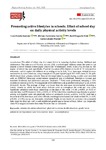Promoting Active Lifestyles in Schools. Effect of School Day on Daily Physical Activity Levels

Use este enlace para citar
http://hdl.handle.net/2183/31514Colecciones
- Investigación (FEDU) [939]
Metadatos
Mostrar el registro completo del ítemTítulo
Promoting Active Lifestyles in Schools. Effect of School Day on Daily Physical Activity LevelsFecha
2022Cita bibliográfica
Varela-Garrote L, Carretero-García M, Fraguela-Vale R, Losada-Puente L. Promoting active lifestyles in schools. Effect of school day on daily physical activity levels. Phys Act Rev 2022; 10(1): 130-140. doi: 10.16926/par.2022.10.14
Resumen
[Abstract] Introduction: The effect of school day is a major factor in everyday rhythms during childhood and adolescence. The relevance of Physical Activity (PA) in school-aged children raises the need to: (a) analyse whether Primary School pupils achieve the recommended levels of daily PA; (b) find out the impact of school day and, specifically, Physical Education (PE) classes on levels of PA compared to weekends; and (c) explore the differences according to sex in daily PA at these ages. Method: A cross-sectional study was carried out, using a sample of 126 participants (aged 10.2±0.48 years; 51.6% girls, 48.4% boys) from primary schools. Data on the steps taken by pupils during a week were recorded with an ADXK362 three-axis accelerometer integrated into a wristband. Descriptive (means and standard deviation) and inferential analyses (Student’s T-Test) were performed, assuming a 95% confidence interval (p<0.05). The magnitude of the difference was quantified with power (1-β), α=0.05 (bilateral). Results: The average of steps was lower than the minimum recommended, revealing a weekly pattern in which, the most active children were so throughout the week and vice versa. Significant variations were found depending on the days of the week (r=0.40, p<0.001, d= 0.63) or whether they had PE classes (r=0.65, p<0.001, d= 0.79). School day contributed significantly to greater activity and families were less physically active on weekends (t=6.62, p<0.001, d=0.70). Girls had a lower level of PA than boys, and more difficulty reaching the recommended levels of daily PA (t=-4.05, p<0.001, d=0.96), except on weekends. Conclusion: Pupils do not reach the minimum recommended daily steps for their age, with a well-established gender gap in favour of boys. School day (especially when PE is taught) increases their daily PA more than at weekends.
Palabras clave
Primary education
School time
Physical education
Health education
Gender roles
School time
Physical education
Health education
Gender roles
Versión del editor
Derechos
Atribución 4.0 Internacional






